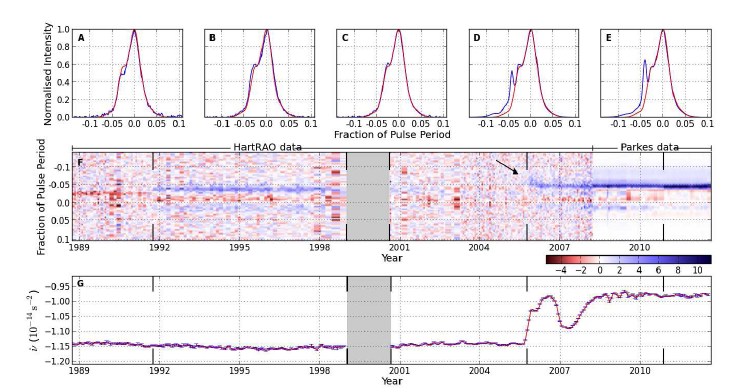Left click on image for large version. Credit: M Gaylard / HartRAO
Sarah Buchner with the 26m telescope at HartRAO.

HartRAO Home > news > Asteroid hits a Pulsar - 2014-01-28
At the end of their lives, heavyweight stars explode as supernovae and leave
behind a collapsed remnant, a neutron star. The extreme magnetic fields at
their north and south magnetic poles produce beams of radiation and as the
neutron star rotates these flash past us, creating what we see as
regular pulses. Hence such objects are known as 'pulsars'.
A rapidly rotating neutron star is a huge flywheel with a very stable rotation rate. It therefore acts as a clock which has allowed us to use pulsars to discover extra-solar planets, probe the interstellar medium and in the near future, hopefully detect gravitational waves.
It has been assumed that the average pulse profile remains stable over decades of observations. In recent years this assumption has been challenged as a small number of pulsars have been discovered whose average profile switches between states on long time scales. Some of these changes in profile are correlated with changes in the spin down of the pulsar.
In 2008 Cordes and Shannon predicted that asteroids formed in the supernova may fall into the pulsar's magnetosphere causing changes in the emission and spin properties.
The pulsar PSR J0738-4042 is a bright radio pulsar. It has been studied for 24 years using the 26m HartRAO radio telescope. As the telescope is relatively small, pulsar research using it has focused on frequent observations of bright pulsars such as this one.
In 2010 Aris Karaastergiou spoke at a conference in Sardinia about changes in the pulse profile of this pulsar. HartRAO astronomer Sarah Buchner was in the audience and mentioned that HartRAO had archival data on the pulsar. When these data were analysed it was found that pulse profile changes had occurred that coincided with a change in the spin properties of the pulsar.
A team lead by PhD student Paul Brook investigated the phenomena further. The team says that the most likely explanation is that this event is the result of an asteroid encounter with the pulsar or debris falling in from a surrounding disk.
The work has been accepted by the Astrophysical Journal and is available on arxiv.
For more information see:
medium - physics - arxiv - blog
Left click on image for large version. Credit: M Gaylard / HartRAO
Sarah Buchner with the 26m telescope at HartRAO.

The middle image (panel F) shows the difference between a constant, median, pulse profile, in red, and the data, in blue, in which the emergence of a new emission component is seen, marked by an arrow.
The bottom image (panel G) shows the changes in the pulsar spin-down rate with time, and highlights the big change that occurred when the new pulse component appeared.